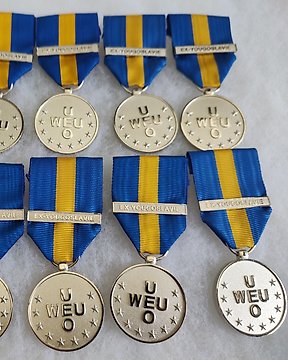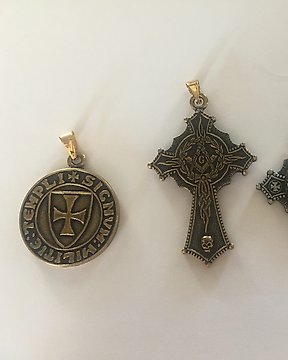top piece
Katso käännösAmerikan yhdysvallat - Kaunis WW2 Yhdysvaltain armeijan villapaita - 1st Armored Division "Old Ironsides" - Afrikka - - Sotilaallinen univormu - Suurikokoinen
Nro. 84824673



Nice 100% original WW2 US Army 1st Armored Division Wool shirt, an early model WITH gas flap, also a nice size and complete, see photo's.. The shirt is in nice condition and has an originally applied 1st armored division patch and Technician 5th Grade Rank Chevrons. Overall a nice large shirt, in very nice condition - should be investigated more. The label has is also still present and dates the shirt to 1942.
A very nice and 100% original shirt of the famous 1st Armored Division from WW2!
History of the 1st armored division ''Old Ironsides''
A volunteer troop of three M3 Lee crews from the 1st Armored Division commanded by Henry Cabot Lodge Jr. fought in the Battle of Gazala under British command in June 1942, becoming the first Americans to engage the Germans on land in the war (* Major Lodge was not in one of the three tanks which actually fought).[5]
Alerted for the invasion were the 1st Battalion of the 1st Armored Regiment, the 1st and 2nd Battalions of the 13th Armored Regiment, nearly all the 6th Armored Infantry Regiment, the 27th Armored Field Artillery Battalion, "B" and "C" Companies of the 701st Tank Destroyer Battalion, and detachments of the 16th Armored Engineer Battalion, the Supply Battalion, the Maintenance Battalion, 47th Armored Medical Battalion, and the 141st Signal Company.
The unit's proper first contact with an enemy was as part of the Allied invasion of Northwest Africa, Operation Torch, on 8 November 1942. Elements of the division became part of the Northern Task Force and became the first American armored division to see combat in World War II. Combat Command B (CCB) of the division landed east and west of Oran under the command of Brigadier General Lunsford E. Oliver and entered the city on 10 November 1942. On 24 November 1942, CCB moved from Tafraoui, Algeria to Bedja, Tunisia, and raided the Djedeida airfield the next day and conquered the city on 28 November 1942. CCB moved southwest of Tebourba on 1 December 1942, engaged with German forces on El Guessa Heights on 3 December 1942, but its lines were pierced on 6 December 1942. CCB withdrew to Bedja with heavy equipment losses between 10 and 11 December 1942 and was placed in reserve. CCB next attacked in the Ousseltia Valley on 21 January 1943, and cleared that area until 29 January 1943 when sent to Bou Chebka, and arrived at Maktar on 14 February 1943.
Combat Command A (CCA) fought at Faïd Pass commencing on 30 January 1943, and advanced to Sidi Bou Zid, where it was pushed back with heavy tank losses on 14 February 1943, and had elements isolated on Djebel Lessouda, Djebel Kasaira, and Garet Hadid. Combat Command C (CCC), which was formed on 23 January 1943 to raid Sened Station on 24 January, advanced towards Sbeita and counterattacked to support CCA in the Sidi Bou Zid area on 15 February 1943, but was forced to retreat with heavy losses. The division withdrew from Sbeita on 16 February 1943, but by 21 February 1943 CCB contained the German attack toward Tébessa. The German withdrawal allowed the division to recover Kasserine Pass on 26 February 1943 and assemble in reserve. The division moved northeast of Gafsa on 13 March 1943 and attacked in heavy rains on 17 March 1943 as CCA took Zannouch, but became immobilized by rain the next day. The division drove on Maknassy on 20 March 1943, and fought the Battle of Djebel Naemia on 22–25 March 1943, and then fought to break through positions barring the road to Gabès between 29 March and 1 April 1943. It followed up on the withdrawing German forces on 6 April 1943 and attacked towards Mateur with CCA on 27 April 1943, which fell after fighting on Hill 315 and Hill 299 on 3 May 1943. The division, now commanded by Major General Ernest N. Harmon, fought the Battle for Djebel Achtel between 5 and 11 May 1943 and entered Ferryville on 7 May 1943. With the British forces taking Tunis and Americans in Bizerte, the Axis forces in Tunisia surrendered between 9 and 13 May 1943. The division was reorganized in French Morocco and began arriving in Naples, Italy on 28 October 1943.
Exhibit at the 1st Armored Division and Fort Bliss museum depicts the type of bivouac site used in North Africa in WWII. Soldiers slept in cloth tents and carried chests of equipment and stoves.
After the Allied invasion of Sicily, the 1st Armored Division, which was part of the American Fifth Army, invaded mainland Italy. It participated in the attack on the Winter Line in November 1943, flanked the Axis armies in the landings at Anzio, and passed through the city of Rome and pursued the retreating enemy northward until mid-July 1944. At that point, Harmon was replaced by Major General Vernon Prichard, who led the 1st AD for the rest of the war. Three days after Prichard took command, the division was reorganized based on experiences in the North Africa Campaign.[6] The change was drastic: it eliminated the armored and infantry regiments in favor of three separate tank and infantry battalions, disbanded the Supply Battalion, and cut the strength of the division from 14,000 to 10,000. The result of the reorganization was a more flexible and balanced division, with roughly equivalent infantry and tank battalions. These forces could be combined or custom-tailored by the command to meet any situation. The additional infantry strength would prove particularly useful in future campaigns in the largely mountainous combat of the Italian campaign. The division continued in combat to the Po Valley until the German forces in Italy surrendered on 2 May 1945. In June, the division moved to Germany as part of the occupation forces.
Nice 100% original WW2 US Army 1st Armored Division Wool shirt, an early model WITH gas flap, also a nice size and complete, see photo's.. The shirt is in nice condition and has an originally applied 1st armored division patch and Technician 5th Grade Rank Chevrons. Overall a nice large shirt, in very nice condition - should be investigated more. The label has is also still present and dates the shirt to 1942.
A very nice and 100% original shirt of the famous 1st Armored Division from WW2!
History of the 1st armored division ''Old Ironsides''
A volunteer troop of three M3 Lee crews from the 1st Armored Division commanded by Henry Cabot Lodge Jr. fought in the Battle of Gazala under British command in June 1942, becoming the first Americans to engage the Germans on land in the war (* Major Lodge was not in one of the three tanks which actually fought).[5]
Alerted for the invasion were the 1st Battalion of the 1st Armored Regiment, the 1st and 2nd Battalions of the 13th Armored Regiment, nearly all the 6th Armored Infantry Regiment, the 27th Armored Field Artillery Battalion, "B" and "C" Companies of the 701st Tank Destroyer Battalion, and detachments of the 16th Armored Engineer Battalion, the Supply Battalion, the Maintenance Battalion, 47th Armored Medical Battalion, and the 141st Signal Company.
The unit's proper first contact with an enemy was as part of the Allied invasion of Northwest Africa, Operation Torch, on 8 November 1942. Elements of the division became part of the Northern Task Force and became the first American armored division to see combat in World War II. Combat Command B (CCB) of the division landed east and west of Oran under the command of Brigadier General Lunsford E. Oliver and entered the city on 10 November 1942. On 24 November 1942, CCB moved from Tafraoui, Algeria to Bedja, Tunisia, and raided the Djedeida airfield the next day and conquered the city on 28 November 1942. CCB moved southwest of Tebourba on 1 December 1942, engaged with German forces on El Guessa Heights on 3 December 1942, but its lines were pierced on 6 December 1942. CCB withdrew to Bedja with heavy equipment losses between 10 and 11 December 1942 and was placed in reserve. CCB next attacked in the Ousseltia Valley on 21 January 1943, and cleared that area until 29 January 1943 when sent to Bou Chebka, and arrived at Maktar on 14 February 1943.
Combat Command A (CCA) fought at Faïd Pass commencing on 30 January 1943, and advanced to Sidi Bou Zid, where it was pushed back with heavy tank losses on 14 February 1943, and had elements isolated on Djebel Lessouda, Djebel Kasaira, and Garet Hadid. Combat Command C (CCC), which was formed on 23 January 1943 to raid Sened Station on 24 January, advanced towards Sbeita and counterattacked to support CCA in the Sidi Bou Zid area on 15 February 1943, but was forced to retreat with heavy losses. The division withdrew from Sbeita on 16 February 1943, but by 21 February 1943 CCB contained the German attack toward Tébessa. The German withdrawal allowed the division to recover Kasserine Pass on 26 February 1943 and assemble in reserve. The division moved northeast of Gafsa on 13 March 1943 and attacked in heavy rains on 17 March 1943 as CCA took Zannouch, but became immobilized by rain the next day. The division drove on Maknassy on 20 March 1943, and fought the Battle of Djebel Naemia on 22–25 March 1943, and then fought to break through positions barring the road to Gabès between 29 March and 1 April 1943. It followed up on the withdrawing German forces on 6 April 1943 and attacked towards Mateur with CCA on 27 April 1943, which fell after fighting on Hill 315 and Hill 299 on 3 May 1943. The division, now commanded by Major General Ernest N. Harmon, fought the Battle for Djebel Achtel between 5 and 11 May 1943 and entered Ferryville on 7 May 1943. With the British forces taking Tunis and Americans in Bizerte, the Axis forces in Tunisia surrendered between 9 and 13 May 1943. The division was reorganized in French Morocco and began arriving in Naples, Italy on 28 October 1943.
Exhibit at the 1st Armored Division and Fort Bliss museum depicts the type of bivouac site used in North Africa in WWII. Soldiers slept in cloth tents and carried chests of equipment and stoves.
After the Allied invasion of Sicily, the 1st Armored Division, which was part of the American Fifth Army, invaded mainland Italy. It participated in the attack on the Winter Line in November 1943, flanked the Axis armies in the landings at Anzio, and passed through the city of Rome and pursued the retreating enemy northward until mid-July 1944. At that point, Harmon was replaced by Major General Vernon Prichard, who led the 1st AD for the rest of the war. Three days after Prichard took command, the division was reorganized based on experiences in the North Africa Campaign.[6] The change was drastic: it eliminated the armored and infantry regiments in favor of three separate tank and infantry battalions, disbanded the Supply Battalion, and cut the strength of the division from 14,000 to 10,000. The result of the reorganization was a more flexible and balanced division, with roughly equivalent infantry and tank battalions. These forces could be combined or custom-tailored by the command to meet any situation. The additional infantry strength would prove particularly useful in future campaigns in the largely mountainous combat of the Italian campaign. The division continued in combat to the Po Valley until the German forces in Italy surrendered on 2 May 1945. In June, the division moved to Germany as part of the occupation forces.
- 639
- 14
- 2
Parfait; très bien emballé.
Katso käännösHet object zag er keurig uit en was erg veilig verpakt. Niets meer dan lof!
Katso käännöslibro perfetto, come da descrizione ed immagini, consegna puntuale in buon imballaggio, eccellente.
Katso käännösHeel mooi boekje, goed verpakt en snel verstuurd. Bedankt!
Katso käännösNetjes verzonden en alles zoals omschreven. Heel blij mee bedankt! 👍
Katso käännössome blank and cut sheets
Katso käännösExactly, as mentioned in the description: '' NOTE: in the US section some insignia photo's were cut out (see attached photo's).'', so with photo's added. How could it possible be more clear?
Heel snel geleverd. Object was ook goed verpakt. Object zelf (kompas uit WO II) was precies zoals omschreven. Prachtig stuk.
Katso käännösPerfect!!! Thanks.
Katso käännösWell packed, send quickly. Product as shown. Recommended seller.
Katso käännösServizio ottimo e rapido😉👍🏻
Katso käännösSnel en in goede orde ontvangen. Erg mooi. bedankt.
Katso käännössnel bezorgd goed ingepakt een eerlijke verkoper
Katso käännösOttimo affare, venditore consigliato!
Katso käännösBen een aantal dagen in het buitenland. Het item werd (snel) afgeleverd bij de dochter. Kreeg geen enkele negatieve commentaar.
Katso käännösGreat seller !!!
Katso käännösGreat seller !!!
Katso käännössehr guter Zustand------hat mir auch incl. Versand und Aufgeld € 105.-gekostet
Katso käännöspakket geleverd als op de foto's.
Katso käännösHeel mooi aankoop dank U
Katso käännösFine book, quick and safe (!) delivery. Thank you!
Katso käännösTrès bel objet, envoi très rapide, vendeur à recommander. Merci.
Katso käännösGreat thanks a lot!
Katso käännösSnelle verzending, alles perfect!
Katso käännösTransaction parfaite. Expédition éclaire. Très positif
Katso käännösVastuuvapauslauseke
Kohteen esineet ovat tarkoitettu yksinoikeudella sotahistoriallisten esineiden keräiljöille. Tämän sivuston omistajalle ei ole poliittisia tai muita motiiveja kuin tarjota alusta, jonka huutokaupoissa kolmannet osapuolet voivat ostaa tai myydä kohteita. Sivuston omistaja ei ole vastuussa kohteiden sisällöstä.
Kohteen esineet ovat tarkoitettu yksinoikeudella sotahistoriallisten esineiden keräiljöille. Tämän sivuston omistajalle ei ole poliittisia tai muita motiiveja kuin tarjota alusta, jonka huutokaupoissa kolmannet osapuolet voivat ostaa tai myydä kohteita. Sivuston omistaja ei ole vastuussa kohteiden sisällöstä.









